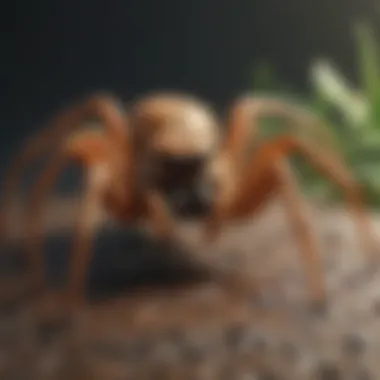Effective Strategies to Eliminate Outdoor Spiders


Intro
Outdoor spiders can be an unpleasant surprise for homeowners. Their presence might evoke discomfort or even fear, especially for those who are not fond of eight-legged creatures. Understanding these pests is crucial in managing and mitigating their impact on our outdoor spaces. In this guide, we will delve into the specifics of spider behavior, prevention methods, and various control strategies. This information will help empower homeowners to maintain their gardens and yards free from spider intrusions.
Understanding the Pest
Identification
Spiders come in various shapes, sizes, and colors. Identifying the spider species present around your home is the first step in addressing the issue. Common species like the garden spider, wolf spider, and black widow each have distinctive characteristics. For instance, the black widow is easily recognized by its glossy black body and red hourglass marking.
Key identifiers include:
- Size: Spiders can range from less than 1mm to over 10cm in length.
- Color: Many spiders have a brown, black, or gray coloration with varied patterns.
- Web type: Some spiders create webs, while others do not; this may help in identification.
Life Cycle
Understanding the life cycle of spiders can give insights into their population dynamics. Spiders undergo several life stages, starting from eggs to adulthood. The typical life cycle includes:
- Eggs: Female spiders lay eggs in silk sacs, often hidden in vegetation or under debris.
- Spiderlings: These hatchlings emerge from the eggs and usually disperse shortly after.
- Juveniles: As spiders grow, they shed their exoskeletons several times.
- Adults: After reaching maturity, adult spiders mate and continue the cycle.
The time from egg to adult varies by species, but understanding these stages can inform timing for prevention and control efforts.
Pest Prevention Strategies
Environment Modification
Spiders thrive in environments that provide food and shelter. Modifying your outdoor space can reduce their attractiveness. Consider these tips:
- Clear debris: Regularly remove piles of leaves, logs, or rocks where spiders may hide.
- Maintain vegetation: Trim shrubs and grass periodically to diminish potential habitats.
- Lighting choices: Use yellow or sodium vapor lights outdoors, which are less attractive to insects, the primary food source for spiders.
Physical Barriers
Using physical barriers can effectively deter spiders. Adequate measures include:
- Sealing entry points: Inspect windows, doors, and cracks in the foundation, sealing any gaps with caulk or weather stripping.
- Netting: Installing mesh screens or netting over porches and patios can prevent spiders from entering living spaces.
Control Methods
Chemical Control
In cases where spiders persist despite prevention efforts, chemical options may be necessary.
- Insecticides: Look for products labeled specifically for spiders, like pyrethrins and permethrin. Follow label instructions carefully.
- Residual sprays: Apply these to spider-prone areas, such as eaves and corners of buildings.
"Proper application of chemical solutions is vital to minimize harm to beneficial insects and the environment."
Biological Control
Incorporating natural predators into your yard can help manage spider populations. For example, birds, which feed on spiders and insects, can be encouraged by adding birdhouses or feeding stations. Additionally, certain insect species, like ladybugs, can keep pest numbers low, reducing food sources for spiders.
By combining various prevention methods and control strategies, homeowners can create an outdoor environment that discourages spider populations while fostering a healthy ecosystem.
Prelims to Spider Control
Managing outdoor spiders is essential for maintaining a comfortable and safe living environment. This subject is not just about eliminating pests but understanding their behaviors and ecological significance. Many homeowners struggle with the presence of these arachnids, often feeling discomfort due to their mere presence. Recognizing the need for spider control can lead to effective strategies that not only repel these creatures but also promote a healthier ecosystem in residential spaces.
Understanding Spider Behavior
To effectively control spiders, it is crucial to understand their behavior. Spiders are primarily nocturnal hunters, relying on their webs for trapping insects. They exhibit territorial habits and tend to favor specific environments that provide shelter and food. For instance, garden spiders thrive in areas with abundant vegetation while wolf spiders prefer less dense habitats.
Knowing how spiders behave can aid in preventing infestations. For example, if areas around a home are dark and moist, it may attract these pests. Homeowners should be aware of the specific habitats that encourage spider activity and take proactive steps to minimize these conditions.
The Role of Spiders in Ecosystems


Spiders play a significant role in the ecosystem. They help control insect populations, which is vital for maintaining a balanced environment. By preying on pests, spiders naturally reduce the number of insects that can cause damage to plants and gardens. This contributes to healthier outdoor spaces and reduces the need for chemical pesticides, which can have harmful effects on biodiversity.
However, while their ecological roles are beneficial, the presence of spiders in home gardens can be troubling for some residents. Understanding this balance is crucial.
- Spiders help eliminate pests like mosquitoes and flies.
- They serve as food for birds and other wildlife.
- Their webs can also capture insect diseases, contributing to a healthier ecosystem.
Homeowners need to recognize that while spiders can be unnerving, their presence is not entirely negative. By managing their existence thoughtfully, one can create a space that minimizes unwanted encounters while still benefiting from their ecological roles.
Identifying Common Outdoor Spiders
Understanding the types of spiders inhabiting your outdoor space is crucial for effective control. By identifying common species, homeowners can tailor their management strategies appropriately. Knowing the characteristics of different spiders helps to differentiate between harmful and beneficial ones. For example, some spiders play a role in controlling insect populations, while others may create more distress for residents. This article emphasizes the importance of recognizing these distinctions to enhance your strategies effectively.
Characteristics of Common Species
Garden Spiders
Garden spiders are often identified by their vibrant patterns and large webs. They are a beneficial species in gardens since they prey on many harmful insects. One key characteristic of garden spiders is their ability to weave complex orb-shaped webs, which they use to capture prey. This natural pest control is beneficial for maintaining an ecological balance. However, these webs can be unattractive and cause annoyance to homeowners.
Wolf Spiders
Wolf spiders have a distinct appearance due to their hairy bodies and large size. Unlike many spiders, they are not web builders. Instead, they hunt their prey actively, making them effective predators. A primary advantage of wolf spiders is that they help control pest populations, reducing reliance on chemical treatments. However, their presence can be alarming to some, given their size and speed. Understanding their role contributes to a more informed pest management approach.
Orb-Weavers
Orb-weavers are renowned for the iconic spiral-shaped webs they create. These spiders are essential for controlling various flying insects. A standout feature of orb-weavers is their ability to produce silk that is strong and elastic. This characteristic allows them to build resilient webs that can withstand adverse weather conditions. While effective in controlling pests, their webs can accumulate dirt and debris, leading to a need for periodic maintenance of outdoor spaces.
Signs of Infestation
Recognizing the signs of spider infestation can aid in early detection. Look for webs in corners of structures, around patios, and between foliage. Presence of spiders is visible in many forms, such as eggs or molted skins. When you start noticing increased sightings or webs, it is an indicator that control measures should be considered.
"A proactive approach to identifying spider types and signs of infestation can greatly reduce the overall presence of spiders in your yard."
Factors That Attract Spiders
Understanding what draws spiders to your outdoor space is essential in creating strategies to manage their populations. Several environmental factors can significantly affect the likelihood of spider presence. By recognizing these elements, homeowners can adopt preventive measures effectively.
Environmental Conditions
Moisture Levels
Moisture plays a crucial role in spider attraction. Spiders thrive in humid environments due to their need for hydration. A damp yard can create ideal conditions for many species, particularly those like Wolf Spiders, which favor moist areas. This characteristic makes moisture levels a top consideration in spider management strategies. Understanding the balance of moisture is necessary as overwatering gardens or not addressing drainage issues can facilitate spider habitation.
While a well-watered garden may seem beneficial for plants, it can create a habitat for spiders. The best approach is regular monitoring of soil and lawn conditions. Gradually draining excess water can discourage spider colonies from settling.
Vegetative Cover
The type and density of vegetative cover can influence spider populations. Areas with dense foliage provide shelter and hunting grounds for spiders. Plants can create a microhabitat where spiders can thrive out of sight. A well-maintained yard with proper spacing can deter spiders by reducing conducive habitats. However, certain plants may attract beneficial insects, which can inadvertently invite spiders into your garden as potential prey.
Interestingly, while vegetation often brings beauty and biodiversity, overgrown areas can lead to unsanitary conditions. Periodic trimming and clearing of dense foliage are effective steps. This not only makes your yard less inviting for spiders but enhances the overall aesthetic of the space.
Presence of Prey
Insects as Food Sources
The availability of insects significantly contributes to spider populations. Spiders are predators and rely on insects for food. Insects like flies, mosquitoes, and ants can increase in number and serve as attracting food sources for spiders. Maintaining a property that’s free of these pests can make your environment less appealing to spider populations.
Promoting good lawn care, including proper disposal of debris and using pest control methods that minimize other insect populations, can lower the chances of spider presence. However, eliminating all insects may not be practical, as some are beneficial to your garden. A balanced approach that protects your plants while managing pest populations is crucial.
In summary, moisture levels, vegetative cover, and presence of prey interact to shape spider presence in outdoor spaces. By addressing these factors, you can effectively minimize unwanted spider populations.
Preventive Measures
Taking preventive measures is essential when dealing with outdoor spiders. The proactive approach can significantly reduce the likelihood of infestations. By employing basic strategies, homeowners can create an environment that is less hospitable to spiders and more enjoyable for themselves and their families. Each measure not only addresses spider populations but also contributes to overall outdoor maintenance.
Decluttering Outdoor Spaces


Clutter can easily attract spiders. When outdoor areas are filled with debris, it creates hiding spots conducive to spider habitats. Items particularly prone to causing problems include old furniture, piles of leaves, or unused gardening tools. Regularly washing these areas helps remove potential shelters. Additionally, keep firewood stacked away from the house and elevate it off the ground. This prevents spiders, along with other pests, from getting too close to living spaces.
Benefits of Decluttering:
- Reduces the likelihood of spider infestations.
- Enhances overall aesthetics of the outdoor space.
- Promotes better usability of gardens and patios.
Sealing Entry Points
Identifying and sealing entry points in residential spaces is a critical task for any homeowner concerned about insects, including spiders. Gaps around doors and windows, cracks in walls, or unfinished areas in basements can provide easy access. Using caulk or weather stripping for doors and windows can effectively reduce those entryways. Check the foundation for cracks, as filling these gaps reduces not only spider entry, but also other pests frequently found in outdoor areas.
Important Note: Regularly inspecting and maintaining properties is key in preventing infestations.
Proper Landscaping Techniques
Landscaping plays a crucial role in pest management. An overgrown yard with excessive vegetation or mulch can attract spiders and their prey. It is advisable to prune shrubs, cut back tall grass, and remove dense foliage. Moreover, using stones or gravel can reduce moisture and deter pests.
Key Landscaping Tips:
- Maintain a distance between shrubs and the house.
- Opt for gravel instead of mulch in garden beds.
- Regularly mow the lawn to prevent tall grass.
By incorporating these preventive measures, homeowners can significantly lessen the chances of spider infestations. Attention to detail in outdoor upkeep not only benefits the home but also promotes a more pleasant and safe environment.
Ecological Control Methods
Ecological control methods serve as a key component in managing spider populations without resorting to harsh chemicals. These techniques emphasize the importance of maintaining a balanced ecosystem. By fostering natural predator-prey relationships and promoting beneficial insects, homeowners can create an environment that discourages spider infestations.
One of the significant benefits of utilizing ecological control methods is the sustainability of approach. It reduces reliance on chemical pesticides, which can have harmful effects on the environment and human health. Additionally, these methods can prove cost-effective in the long run, as they often lead to a self-regulating ecosystem. Furthermore, they align with addressing concerns about long-term health and environmental safety.
Utilizing Natural Predators
Natural predators play a vital role in maintaining spider populations. Birds, lizards, and certain wasps are known to feed on spiders. Homeowners can create a habitat that encourages these predators, thus naturally keeping spiders at bay.
To attract birds, planting native shrubs and trees is effective. Providing bird feeders and water sources can further enhance this attraction. For lizards, maintaining a clutter-free garden with rocks and logs offers ideal shelter and basking spots.
In addition to these practices, it’s essential to minimize application of broad-spectrum insecticides. These chemicals may destroy beneficial insect populations that could otherwise help keep spider numbers low. By fostering an ecosystem teeming with natural predators, one can effectively manage spider populations organically.
Promoting Beneficial Insects
The promotion of beneficial insects is another integral aspect of ecological control methods. These insects help maintain a balanced ecosystem and can naturally control pest populations, including spiders. Ladybugs, lacewings, and predatory beetles are excellent examples of such beneficial insects.
To encourage these insects, it is good practice to plant a diverse array of flowering plants that bloom at different times throughout the growing season. These plants provide food sources like pollen and nectar, attracting beneficial insects and supporting their life cycles. Additionally, minimizing tilling and avoiding the use of pesticides in the garden creates a safer environment for them to thrive.
Implementing companion planting can also support beneficial species. For example, planting marigolds can repel pests while attracting predatory insects. This method enhances biodiversity and acts as a natural barrier against unwanted pests.
In summary, integrating ecological control methods not only helps in managing spider populations but also supports the overall health of the garden ecosystem.
By encouraging natural predators and promoting beneficial insects, homeowners can create a vibrant, self-sustaining outdoor space that minimizes spider presence while enhancing ecological balance.
Chemical Control Solutions
In managing spider populations around residential areas, chemical control solutions play a crucial role. They offer a way to effectively reduce spider numbers, especially when other methods may not yield the desired results. In this section, we will discuss the specific insecticides available, their efficacy, and the safety considerations that come with using chemical treatments.
Insecticides and Their Efficacy
Insecticides are chemical agents designed to kill or repel insects, including spiders. Their efficacy can vary based on the active ingredients, formulation, and application method. Some commonly used insecticides for spider control include pyrethroids, neonics, and bifenthrin.
- Pyrethroids are synthetic chemicals that mimic the natural insecticidal properties of chrysanthemum flowers. They act quickly and are effective against many spider species.
- Neonics disrupt the nervous system of insects, leading to paralysis and death. Their residual effects can control spiders for some time after application.
- Bifenthrin is another potent choice; it provides long-lasting control and is often used in perimeter treatments to keep spiders at bay.
It is important to follow the manufacturer's instructions regarding mixing, application rates, and timing. Applying insecticides during times when spiders are most active can improve their effectiveness.
Safety Considerations
While chemical control solutions can be beneficial, safety is a paramount concern. It is vital for homeowners to consider the following when using insecticides:


- Read Labels: Always review product labels and material safety data sheets before application. This ensures that you understand the risks involved and proper usage guidelines.
- Use Personal Protective Equipment (PPE): Utilize gloves, goggles, and masks during application to minimize exposure to chemicals.
- Avoid Contamination: Make sure to keep pets and children away from treated areas until the product has dried or settled according to the guidelines.
- Environmental Impact: Consider the ecological balance when using chemical treatments. Over-reliance on synthetic insecticides may disrupt beneficial insect populations.
By balancing the use of insecticides with an awareness of safety, homeowners can effectively address spider issues without compromising their health or the environment.
In summary, chemical control solutions can be a powerful ally in managing outdoor spiders. Sifting through options and adhering to safety measures ensures that these solutions can be effective in creating a safer and spider-free outdoor environment.
Targeted Application Techniques
Effective management of spider infestations relies heavily on targeted application techniques. These methods not only optimize the use of pesticides but also align with integrated pest management practices suited for homeowners. Targeted application distinguishes itself by focusing on specific areas and known spider habitats, rather than blanket spraying pesticide across entire properties. This precision minimizes chemical usage and maximizes effectiveness, ensuring that treatments are concentrated where they are most needed.
Spot Treatments vs. Broad Applications
Spot treatments involve applying insecticides directly to areas where spiders are most commonly found. This might include corners of porches, under eaves, or around foundation walls. This method allows for careful management of chemical exposure, reducing risks to beneficial insects and other wildlife. Spot treatments are particularly advantageous for households with children or pets, as they limit the exposure to hazardous substances.
On the other hand, broad applications can lead to unnecessary pesticide use and environmental concerns. They cover large areas indiscriminately, which may eliminate spiders but also harm non-target species. It's important to understand that while broad applications may seem effective at first, they can encourage spider populations to return over time due to indiscriminate killing of predators and pests that naturally regulate spider populations.
Consider employing a combination of both methods: use broad applications sparingly as a preliminary measure, followed by focused spot treatments to maintain control. This approach not only enhances the efficacy of your efforts but also minimizes ecological impact.
Timing of Applications
Timing is critical when applying insecticides for spider control. The effectiveness of treatments can vary greatly depending on when they are applied. Generally, it is advised to conduct spot treatments during cooler parts of the day, early morning or late afternoon. During these times, spiders tend to be less active, increasing the likelihood that they will come into contact with the insecticide.
Moreover, considering the life cycles of spiders can aid in determining the best times for application. For example, applications during spring can be preventive, targeting egg sacs and young spiders as they emerge. Others might consider applying treatments before heavy rain or moisture accumulation, as this serves to eliminate spiders that might seek shelter indoors during wetter months.
"Timed applications aligned with spider behavior maximize effectiveness and reduce unnecessary pesticide use."
Maintaining a Long-Term Spider-Free Zone
Maintaining a long-term spider-free zone is crucial for any homeowner looking to enjoy their outdoor spaces without the nuisance and potential dangers posed by spiders. Proactive measures can ensure that these arachnids do not reclaim your yard after removal. Additionally, essential practices can help reinforce an unwelcoming environment for spiders.
By focusing on consistent management, homeowners can reduce spider populations and maintain a comfortable and safe outdoor atmosphere. The benefits of such strategies extend beyond mere pest elimination; they conserve the ecosystem while safeguarding family members from unwanted encounters with spiders.
Regular Inspection Practices
Regular inspections of outdoor areas play a vital role in keeping spider populations at bay. It is advisable to check potential problem areas, such as corners of structures, under decks, and around plants. Inspecting these spaces routinely can help identify the early signs of spider activity. Signs to look for include web formations, egg sacs, and spider droppings.
Here are some guidelines for effective inspections:
- Schedule inspections every few weeks, especially during seasons when spiders are most active.
- Use a flashlight to better see dark spaces where spiders may hide.
- Document findings to track any spider activity over time, which can help in understanding their patterns.
By remaining vigilant, homeowners can engage in timely actions that can mitigate spider attraction before they establish themselves.
Adaptive Management Strategies
Adaptive management strategies involve adjusting techniques based on observed conditions and spider activity. This process allows homeowners to refine their approach to pest control in response to real-time changes in their yards. Some critical adaptive strategies include:
- Adjusting pesticides: Based on inspection findings, the application of insecticides should be timed and targeted more effectively. For example, if spider activity increases in a specific area, a localized treatment could be applied instead of a broad-based one.
- Modifying environmental conditions: If certain conditions are found to attract spiders, such as excessive moisture or dense foliage, adjustments can be made. Simple steps like trimming vegetation or improving drainage can greatly reduce spider habitats.
- Monitoring and reviewing outcomes: Evaluate the effectiveness of the strategies used. If certain methods do not yield the intended results, be prepared to experiment with alternative control measures or preventive tactics.
Ultimately, maintaining a long-term spider-free zone requires ongoing effort and adaptability. By consistently surveying the area and adjusting strategies, homeowners can create an inhospitable environment for spiders, thus facilitating a pleasant outdoor experience.
Epilogue
In the context of managing outdoor spiders, drawing effective conclusions is vital for any homeowner or pest control professional. Understanding the comprehensive strategies available allows for smarter choices in eliminating spiders while also considering the ecological balance. Spiders may invoke fear or discomfort, yet it's essential to recognize their role in controlling insect populations. Therefore, the approach should strike a balance between effective elimination and maintaining environmental health.
Summary of Effective Strategies
To summarize the effective strategies discussed in this article, homeowners should focus on these key points:
- Prevention First: Regular inspections of property and implementing proper landscaping techniques can greatly reduce spider habitat.
- Natural Solutions: Utilizing natural predators can help control spider populations without harming the ecosystem.
- Chemical Precautions: When using insecticides, it’s crucial to select the right product and apply them safely, considering potential harm to beneficial insects.
- Targeted Applications: Focusing on specific areas where spiders are most likely to establish can yield better results than broad application methods.
These strategies revolve around a proactive and informed approach to spider management, enabling homeowners to reclaim their outdoor spaces without undue harm to the surrounding environment.
Call for Responsible Pest Management
Responsible pest management is not merely a guideline; it is an obligation for every homeowner who seeks a safer outdoor environment. Adopting sustainable management practices is critical. This involves a continuous effort to monitor, assess, and adapt strategies over time. Homeowners should avoid reliance on indiscriminate chemical treatments, which can lead to resistance and may disrupt local ecosystems.
Additionally, cultivating an understanding of spiders and other garden inhabitants encourages a more thoughtful approach. For example, knowing which species are beneficial can change how we view these creatures.
"The goal is to eliminate the problem while respecting nature's balance."
Being informed is a homeowner's best weapon. Educate oneself about the local environment, and engage in practices that promote long-term spider control. By doing so, we can foster healthier backyards while preserving the benefits spiders bring in managing other pest populations.







